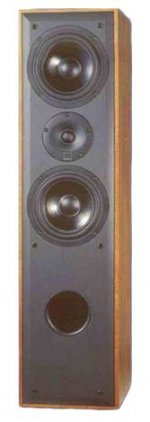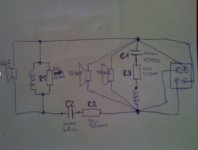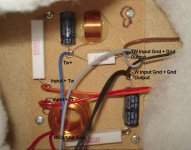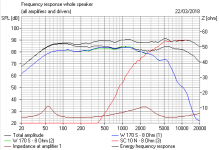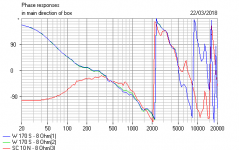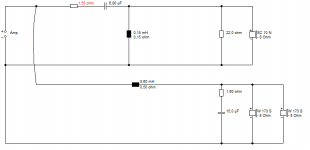Ive built kits before, but I dont have any significant electronics knowledge.
I know about RLC filters, but I have no clue on how to start designing a speaker from scratch.
I can find random pages explaining how to calculate speaker cabinet dimensions for a certain speaker driver, or how to build a crossover, but I dont know how put it all together in the way that makes the most sense.
Suppose I want to build a speaker that performs better than my old Dali 5005's, how do I get there eventually?
Things that come to mind are
- determining what type to build (2 way, 2.5 way, fast / woofer assisted wideband, ...)
- determining what drivers to use
- determining what kind of cabinet to use (TL, TQWT, closed...)
- calculating the dimensions of a cabinet for a *combination* of speakers
- calculating and designing filters / crossover
Does a step by step guide exist that can help a complete beginner like me to get from nothing to a complete self-designed speaker that performs acceptable?
I know about RLC filters, but I have no clue on how to start designing a speaker from scratch.
I can find random pages explaining how to calculate speaker cabinet dimensions for a certain speaker driver, or how to build a crossover, but I dont know how put it all together in the way that makes the most sense.
Suppose I want to build a speaker that performs better than my old Dali 5005's, how do I get there eventually?
Things that come to mind are
- determining what type to build (2 way, 2.5 way, fast / woofer assisted wideband, ...)
- determining what drivers to use
- determining what kind of cabinet to use (TL, TQWT, closed...)
- calculating the dimensions of a cabinet for a *combination* of speakers
- calculating and designing filters / crossover
Does a step by step guide exist that can help a complete beginner like me to get from nothing to a complete self-designed speaker that performs acceptable?
Last edited:
I think you need to decide what style and size of speaker you want first. Do you want a floor standing three way, one your better half would accept . I look through the designer pages , just Google it and go from there.
Personally I loathe the sound of transmission line speakers. To my ears they always sound like the bass caught the bus and the other midrange, treble flew via a Concorde. E.g. the bass sounds delayed.
Personally I loathe the sound of transmission line speakers. To my ears they always sound like the bass caught the bus and the other midrange, treble flew via a Concorde. E.g. the bass sounds delayed.
I suggest the following steps (for 2 way simpy vented bookshelf):
1. calculate box for woofer
2. measure freq response, phase response and impedance of each driver (with no filter) in your box
3. make acoustically phase alligned crossover, which:
- cut tweater 2 octave higher it's impedance resonance
- cut woofer 2 octave lower it's high peak resonance
- correct level of tweater
- correct buffle step effect of drivers
Detailed steps
1) Measure or obtain datasheet for woofer and calculate enclosure for woofer in "Unibox.xls" or similar soft.
Principally there is 3 basic enclosure type: sealed/vented/free air.
All other type are variation of above. Try to start from simple one. Not good idea to start from TL .
Vented enclosure is most popular.
common recomendation:
Qts of 0.4 or below indicates a transducer well suited to a vented enclosure
Qts between 0.4 and 0.7 indicates suitability for a sealed enclosure
Qts of 0.7 or above indicates suitability for free-air or infinite baffle applications
2) Download "Edge.exe" utilite and simulate the size of front buffle - just to see how "Buffle step effect will impact on Frequency response. For your understanding.
"Buffle step effect" means that if driver has flat response in nearfield, this means on the distance starting from 0.6-1 meter the driver will has midrange rise.
This rise of midrange shall be compensated by filter later. Target - to obtain flat response on distance but not in nearfield.
This is the most difficult point. Because at home you do not have possibility to see the real picture of response on the distance due to house wall resonances.
Download ARTA soft package (contain programs Arta and Limp)
Download manual how to make "ARTA BOX" - you have to make this box for impedance measurement. Without impedance data you will not be able to use soft for crossover simulation.
Download LSPCAD 6 (crpssover design soft).
For all measurement each driver must be measured individually, shall be already set in enclosure and connected directly to amp
1. Measure individual frequency response and phase in ARTA from distance 1 meter on tweater axis. Export file to .frd format and rename the file to .txt
2. Measure impedance of each driver and also export to text file
3. Measure frequency response of both drivers and export summary response to text file.
4. Open LSPCAD and put on scheme Generator, ground and connect 2 speakers in parrallel. Open speaker's preferences and attach to each driver impedance file and freq/phase file.
Than go to main menu and find "reference response" or "reference curve" and attach there file of summary frequency response of both drivers.
Go to "Simulate"
Now you should see 4 lines:
WF response simulated
TW response simulated
Summary response simulated.
Refference response measured.
Go to TW properties and find "Dz" (driver deep difference on buffle)
Adjusting Dz make simulated and measured summary response identical.
Add box on sheme and specify box dimension and in driver preferences specify other distances (Xz, Yz) I hope it would be easy.
Now you are ready to design a filter.
Read this link - this is one of most detailed project explaining everything
18W-8434G00
1. calculate box for woofer
2. measure freq response, phase response and impedance of each driver (with no filter) in your box
3. make acoustically phase alligned crossover, which:
- cut tweater 2 octave higher it's impedance resonance
- cut woofer 2 octave lower it's high peak resonance
- correct level of tweater
- correct buffle step effect of drivers
Detailed steps
1) Measure or obtain datasheet for woofer and calculate enclosure for woofer in "Unibox.xls" or similar soft.
Principally there is 3 basic enclosure type: sealed/vented/free air.
All other type are variation of above. Try to start from simple one. Not good idea to start from TL .
Vented enclosure is most popular.
common recomendation:
Qts of 0.4 or below indicates a transducer well suited to a vented enclosure
Qts between 0.4 and 0.7 indicates suitability for a sealed enclosure
Qts of 0.7 or above indicates suitability for free-air or infinite baffle applications
2) Download "Edge.exe" utilite and simulate the size of front buffle - just to see how "Buffle step effect will impact on Frequency response. For your understanding.
"Buffle step effect" means that if driver has flat response in nearfield, this means on the distance starting from 0.6-1 meter the driver will has midrange rise.
This rise of midrange shall be compensated by filter later. Target - to obtain flat response on distance but not in nearfield.
This is the most difficult point. Because at home you do not have possibility to see the real picture of response on the distance due to house wall resonances.
Download ARTA soft package (contain programs Arta and Limp)
Download manual how to make "ARTA BOX" - you have to make this box for impedance measurement. Without impedance data you will not be able to use soft for crossover simulation.
Download LSPCAD 6 (crpssover design soft).
For all measurement each driver must be measured individually, shall be already set in enclosure and connected directly to amp
1. Measure individual frequency response and phase in ARTA from distance 1 meter on tweater axis. Export file to .frd format and rename the file to .txt
2. Measure impedance of each driver and also export to text file
3. Measure frequency response of both drivers and export summary response to text file.
4. Open LSPCAD and put on scheme Generator, ground and connect 2 speakers in parrallel. Open speaker's preferences and attach to each driver impedance file and freq/phase file.
Than go to main menu and find "reference response" or "reference curve" and attach there file of summary frequency response of both drivers.
Go to "Simulate"
Now you should see 4 lines:
WF response simulated
TW response simulated
Summary response simulated.
Refference response measured.
Go to TW properties and find "Dz" (driver deep difference on buffle)
Adjusting Dz make simulated and measured summary response identical.
Add box on sheme and specify box dimension and in driver preferences specify other distances (Xz, Yz) I hope it would be easy.
Now you are ready to design a filter.
Read this link - this is one of most detailed project explaining everything
18W-8434G00
Last edited:
Dmitry M has some good points, but it sounds like you might benefit from some structured reading.
I'm currently reading through the Loudspeaker Design Cookbook. Seems like maybe what you're asking for.
I've seen the book get some flak because it isn't the most advanced and cover every detail of designing a speaker, but that's good for you for now.
I'm currently reading through the Loudspeaker Design Cookbook. Seems like maybe what you're asking for.
I've seen the book get some flak because it isn't the most advanced and cover every detail of designing a speaker, but that's good for you for now.
Good basic to med level loudspeaker design books:
Speaker Building 201, Ray Alden
Introduction to Loudspeaker Design, John L. Murphy
Link for reference reading material list:
The Speaker Building Bible - Techtalk Speaker Building, Audio, Video Discussion Forum
Speaker Building 201, Ray Alden
Introduction to Loudspeaker Design, John L. Murphy
Link for reference reading material list:
The Speaker Building Bible - Techtalk Speaker Building, Audio, Video Discussion Forum
...
Suppose I want to build a speaker that performs better than my old Dali 5005's, how do I get there eventually?
The best start ever one could make in that sense is to modify the existing Dali speakers. There is a fair chance that there still is potential to improve these (XO point 3.500 Hz is to be lowered, check the right summation at XO point, filter steepness out of band, HF padding, baffle step/room placement). I can visualize two outcomes:
- totally successful; skilful and competent
- the exact opposite (performs the same or worse);lack of know-how, the loudspeaker was already optimized to the fullest extent by factory.
Last edited:
I like the woodworking that goes into making a new speaker, and I want to have something else than my old Dali's in my livingroom - I've been looking at them for 15 years now 
Structure is exactly what I'm looking for. I have tons of links on individual subjects, just nothing that binds it together and shows how to combine it all in the best way!
I have good reading on crossovers here on the forum, I have cabinet volume calculators online, I just don't know how to pick drivers for a floorstander, figure out what the best type for me is (2 way? 2.5 way? mtm? Transmission line? Horn? TQWT? Open baffle?), calculate how the inside of the cabinet should look (for TL or TQWT or horn), and so on and so forth.
A book or website that can tell me from A to Z when and why to pick one thing over another would be of great help.
Thanks, I'll be spending the next hours reading!!
Dmitry M has some good points, but it sounds like you might benefit from some structured reading.
I'm currently reading through the Loudspeaker Design Cookbook. Seems like maybe what you're asking for.
I've seen the book get some flak because it isn't the most advanced and cover every detail of designing a speaker, but that's good for you for now.
Structure is exactly what I'm looking for. I have tons of links on individual subjects, just nothing that binds it together and shows how to combine it all in the best way!
I have good reading on crossovers here on the forum, I have cabinet volume calculators online, I just don't know how to pick drivers for a floorstander, figure out what the best type for me is (2 way? 2.5 way? mtm? Transmission line? Horn? TQWT? Open baffle?), calculate how the inside of the cabinet should look (for TL or TQWT or horn), and so on and so forth.
A book or website that can tell me from A to Z when and why to pick one thing over another would be of great help.
Good basic to med level loudspeaker design books:
Speaker Building 201, Ray Alden
Introduction to Loudspeaker Design, John L. Murphy
Link for reference reading material list:
The Speaker Building Bible - Techtalk Speaker Building, Audio, Video Discussion Forum
Thanks, I'll be spending the next hours reading!!
Pygmy, every week I get some imperfect design thrown at me with maybe some room for improvement! 
Actually your Dali 5005 have some good aspects. What's to like? The flattish impedance that will get even cheap feedback amplifiers working reasonably well. Because if the feedback is wildly out of phase with the input, issues of stability arise.
MTM is quite a good idea. These sort of speakers are used in PA applications. The idea is the bass and mid dispersion is cylindrical, so fall off less with distance. TBH, things go horribly wrong with mixing cylindrical bass with a spherical tweeter.
This is a better way to do things:

I had a look at your Dali 5005 in Visaton Boxsim simulator.
Not bad at all! Quite good power response and phase.
TBH, most of the people analysing the crossover didn't have a clue. They just got it plain wrong.
I have seen worse speakers than your twin 6" paper cone plus 1" soft dome tweeter Dali 5005.
Actually your Dali 5005 have some good aspects. What's to like? The flattish impedance that will get even cheap feedback amplifiers working reasonably well. Because if the feedback is wildly out of phase with the input, issues of stability arise.
MTM is quite a good idea. These sort of speakers are used in PA applications. The idea is the bass and mid dispersion is cylindrical, so fall off less with distance. TBH, things go horribly wrong with mixing cylindrical bass with a spherical tweeter.
This is a better way to do things:
I had a look at your Dali 5005 in Visaton Boxsim simulator.
Not bad at all! Quite good power response and phase.
TBH, most of the people analysing the crossover didn't have a clue. They just got it plain wrong.
I have seen worse speakers than your twin 6" paper cone plus 1" soft dome tweeter Dali 5005.
Attachments
Last edited:
Anyone ever experiment with a "dual chamber bass reflex" box where the second chamber was configured as a labyrinth/transmission line? The primary box is ported to both the externally and to the transmission line chamber. The ports can be tuned to resonate to differing frequencies so that the overall production of sound is aimed to be at the two peaks: one from the primary box and the other from the TL. Thus, hopefully, obtaining a wider band in the lower frequencies, and hopefully better over all sound from a relatively small woofer.
- Status
- This old topic is closed. If you want to reopen this topic, contact a moderator using the "Report Post" button.
- Home
- Loudspeakers
- Multi-Way
- How to go about learning to design my own speaker?
